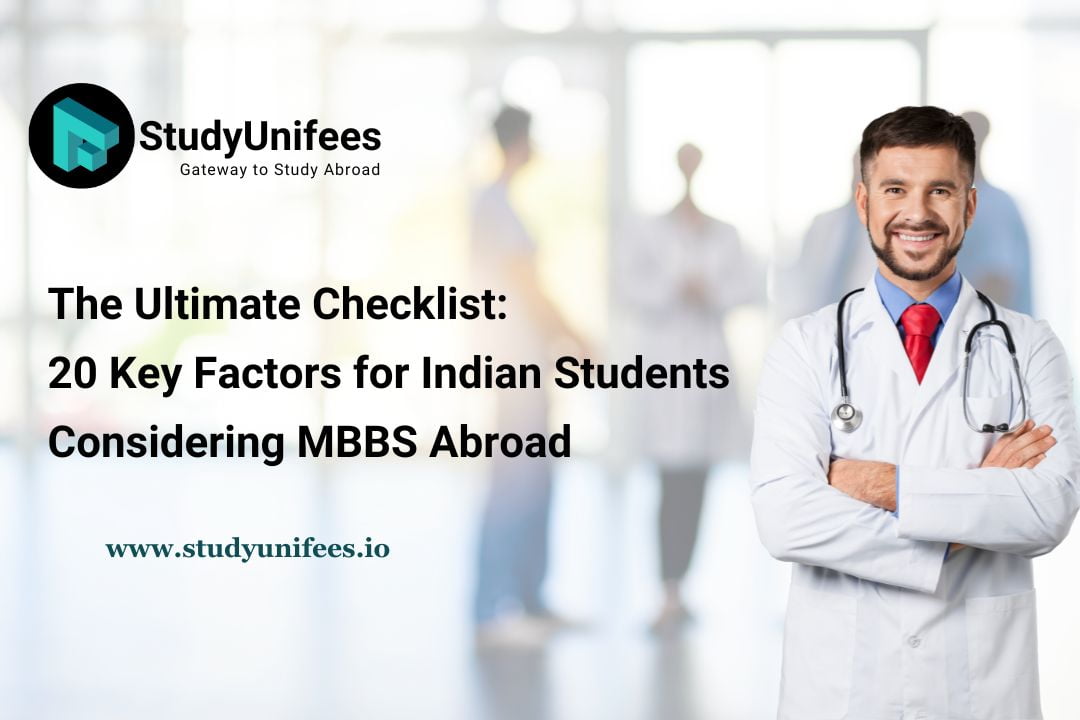For many Indian students aspiring to become doctors, the idea of studying MBBS abroad is both exciting and challenging. The global exposure, advanced learning methods, and often more affordable tuition fees are significant draws. However, selecting the right medical university abroad is crucial for ensuring a successful career in medicine. In this blog we will discuss 20 factors that Indian students should consider when choosing a medical university abroad and highlight the history and differences between pursuing an MBBS abroad and in India.
20 Factors to Consider When Choosing a Medical University Abroad
- Recognition and Accreditation: First and foremost, ensure that the medical university abroad is recognized by the World Health Organization (WHO) and the National Medical Commission (NMC) of India. This recognition is crucial for your degree to be valid in India and globally.
- Curriculum and Teaching Methods: The curriculum should align with international standards, and teaching methods should involve both theoretical and practical learning. This ensures a comprehensive understanding of medicine.
- Language of Instruction: The medium of instruction is critical. Universities offering MBBS courses in English are preferable for Indian students to avoid language barriers in learning.
- Quality of Faculty: Research the university’s faculty qualifications and experience. Having seasoned medical professionals as instructors ensures quality education and practical insights.
- Infrastructure and Facilities: Good infrastructure, such as well-equipped labs, modern libraries, and clinical training facilities, are vital for practical learning experiences.
- Clinical Exposure: Check the university’s affiliations with hospitals for clinical rotations. Hands-on clinical exposure is crucial in medical education.
- Global Recognition and Mobility: A degree from a globally recognized university opens doors to practice in various countries, subject to passing the respective medical licensing exams.
- Cost of Education: Compare the tuition fees and living expenses. Often, MBBS abroad can be more affordable than private medical colleges in India.
- Safety and Environment: Consider the safety standards and general environment of the country and city where the university is located, as you will be living there for several years.
- Student Support Services: Look for universities that offer strong support services for international students, including assistance with accommodation, visa processes, and adaptation to the local environment.
- Cultural Adaptation: Understanding the cultural aspects of the host country is essential for a comfortable stay during your studies.
- Proximity to India: Universities closer to India can be advantageous in terms of travel costs and ease of visiting home during breaks.
- Alumni Network: A strong network of alumni can provide guidance and support during and after the MBBS course.
- Research Opportunities: Universities offering research opportunities help students gain additional experience and bolster their medical careers.
- Post-Graduation Opportunities: Research what opportunities are available post-graduation, including specializations and job placements.
- Accommodation: University-provided accommodation vs. private options can make a significant difference in terms of cost and convenience.
- Visa Regulations: Understand the visa regulations of the host country and ensure compliance with them throughout your stay.
- Pass Percentage in FMGE: Check the pass percentage of the university’s graduates in the FMGE (Foreign Medical Graduates Examination) in India.
- Lifestyle and Climate: Adaptability to the country’s lifestyle and climate is crucial for your well-being during your studies.
- Long-term Career Goals: Choose a university that aligns with your long-term career aspirations, whether it is practicing in India or abroad.
History of Indian Students Going Abroad for MBBS
The trend of Indian students going abroad for MBBS has a rich history, tracing back to several decades. Initially, the United Kingdom and the United States were the preferred destinations due to their advanced medical education. However, over time, with rising costs and stringent admission criteria in these countries, Indian students started exploring other destinations like Russia, China, the Philippines, and Eastern European countries. These countries offered medical education at a fraction of the cost with simpler admission processes. The trend has seen a steady increase, with thousands of Indian students now opting to study MBBS abroad every year.
10 Differences Between Pursuing an MBBS Abroad and in India
- Admission Process: MBBS admissions in India are highly competitive, requiring high NEET scores. In contrast, universities abroad often have less stringent entrance criteria.
- Cost of Education: Studying MBBS abroad can be more cost-effective compared to private medical colleges in India.
- Exposure to Diverse Healthcare Systems: MBBS abroad offers exposure to different healthcare systems, enhancing the student’s adaptability and global medical perspective.
- Curriculum Differences: The curriculum abroad might have a different focus or structure compared to Indian MBBS courses.
- Language and Cultural Exposure: Studying abroad involves adapting to a new language and culture, which adds to a student’s personal and professional growth.
- Clinical Exposure: Clinical training in foreign universities often involves working in hospitals from the early years of the course.
- Recognition of Degree: MBBS degrees from abroad require passing the FMGE to be recognized in India, whereas degrees from Indian institutions are automatically recognized.
- Research Opportunities: Foreign universities often provide better research opportunities due to higher funding and resources.
- Class Size and Individual Attention: Foreign universities might have smaller class sizes, allowing for more individualized attention.
- Postgraduate Specialization: Pursuing postgraduate medical specializations can be more straightforward in the country where you studied your MBBS.
Studying MBBS abroad is an attractive option for Indian students, offering quality education, global exposure, and often at a lower cost. However, choosing the right medical university is crucial. Consider factors like recognition, curriculum, faculty, costs, and post-graduation opportunities. Understanding the differences between pursuing MBBS abroad and in India, along with the rich history of Indian students studying overseas, can guide students in making informed decisions about their medical education and career path.
Challenges Faced by Indian Students Returning After Completing MBBS Abroad
Indian students returning home after completing their MBBS degrees abroad often confront a host of challenges. These can range from bureaucratic hurdles to adapting to the medical landscape in India. Understanding these problems is crucial for those considering MBBS abroad.
- Clearing the Foreign Medical Graduates Examination (FMGE): One of the most significant hurdles is the mandatory Foreign Medical Graduates Examination (FMGE), which assesses the medical knowledge of students against Indian standards. The FMGE has a reputation for being a tough examination, with historically low pass rates. This exam becomes a critical stress point for graduates who have studied in countries with different medical curricula and practices.
- Internship Recognition: Another issue is the recognition of their internship. Some Indian states do not recognize the one-year internship done abroad, necessitating students to redo their internship in India. This can extend their journey to becoming a full-fledged doctor, adding to the time and financial pressures.
- Adaptation to the Indian Medical System: The transition from the healthcare system of a foreign country to India’s unique medical environment poses significant challenges. Differences in patient profiles, disease prevalence, healthcare practices, and the hospital management systems require considerable adjustment. This adaptation phase can be overwhelming for many returnees.
- Societal and Professional Acceptance: There is often a stigma attached to doctors who have completed their education abroad, especially from countries perceived to have lower medical education standards. This skepticism, sometimes even among professional peers, can lead to a lack of confidence and can be disheartening for returning doctors.
- Employment Challenges: Securing employment is another significant challenge. The fierce competition in the Indian healthcare sector, combined with a preference for graduates from Indian medical colleges, makes job hunting difficult for those who have studied abroad. This is compounded by the delay caused by the additional steps they must complete, like passing the FMGE.
- Cultural and Psychological Adjustments: Returning students often experience a reverse culture shock. The adjustment to the Indian way of life, after spending years in a different cultural and academic setting, can be stressful. It can impact their personal and professional life, leading to feelings of isolation or alienation.
- Keeping Up with Indian Medical Regulations: Staying updated with the ever-evolving Indian medical regulations and guidelines is another area of concern. This includes understanding the legal aspects, medical ethics, and patient rights specific to the Indian context.
The journey of an Indian student returning after completing an MBBS abroad is fraught with challenges, from passing stringent examinations to adapting to the medical and cultural landscape of India. While these obstacles are significant, with proper preparation, determination, and support, they can be navigated successfully. It’s important for aspirants and returnees to stay informed, seek guidance, and remain adaptable to overcome these hurdles and achieve their dream of practicing medicine in India.


